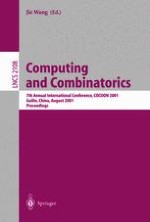2001 | Buch
Computing and Combinatorics
7th Annual International Conference, COCOON 2001 Guilin, China, August 20–23, 2001 Proceedings
herausgegeben von: Jie Wang
Verlag: Springer Berlin Heidelberg
Buchreihe : Lecture Notes in Computer Science
Enthalten in: Professional Book Archive
